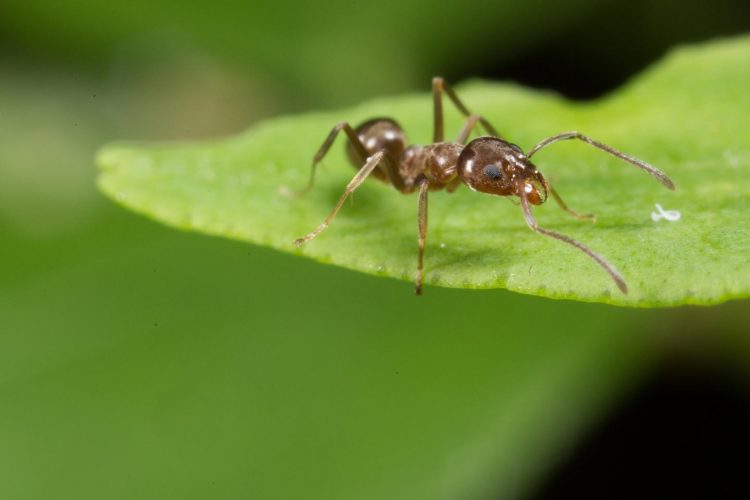Study sheds light on chemicals that insects use to communicate and survive

Most insects, such as the Argentine ant seen here, are covered with a thin layer of hydrocarbon molecules as a waterproofing barrier. Credit Mike Lewis, CISR, UC Riverside
Most insects are covered with a thin layer of hydrocarbon molecules as a waterproofing barrier. Embedded in this layer are compounds that the insects use as chemical signals for a wide variety of functions such as communicating species and sex. In insects such as ants that live in colonies, they also differentiate the different castes (e.g., workers, queens, and drones).
But isolating these chemicals and determining their absolute configuration and functions has been a challenge because the chemicals occur in complex mixtures which are hard to separate.
Now a team of entomologists and chemists at the University of California, Riverside has devised a straightforward method for purifying these compounds that could result in new “green” methods of controlling pest species, like ants, by disrupting the organization of their colonies.
The researchers devised a technique that combined known fractionation methods with reverse phase high performance liquid chromatography – powerful tools in analysis. Specifically, they used their method to isolate 36 pure hydrocarbon molecules from the complex blends of 20 randomly chosen species in nine insect orders, so that these compounds could be conclusively identified, and the effects of the individual chemicals could be tested.
“In so-called social insects that live in large colonies, such as ants and bees, these chemicals have additional functions,” explained Jocelyn G. Millar, a professor of entomology and chemistry, whose lab led the research team. “The queen in these colonies, for example, uses the chemicals to prevent her workers from laying eggs of their own, ensuring that she remains the only reproducing female in the colony.”
The efforts of his research team were complicated by the fact that these chemicals can occur in right-handed (R) or left-handed (known as S, from sinistro, the Latin word for left) forms. Moreover, Millar and his colleagues did not know whether some insects produce the R form and others produce the S, or whether they all produced one form.
“This is critical information for biological activity, because if you have the wrong form, it is like trying to put your right hand into a left-hand glove,” Millar said. “The wrong form of the chemical will simply not fit into its biological receptor.”
His team was able to solve this problem by showing that all 20 insects that were tested had, regardless of species, sex and life stage, the R form of these chemicals.
“This suggests strongly that nearly all insects are likely to produce the R form of these chemicals,” Millar said. “Knowing this will be of great help in unravelling what these signals do and how they work.”
###
Study results appear online this week in the Proceedings of the National Academy of Sciences.
Millar was joined in the research by Ph.D. chemistry student Jan E. Bello and entomologist J. Steven McElfresh. The study was partly funded by a grant to Millar from the Hatch Project of the National Institute of Food and Agriculture, U.S. Department of Agriculture.
The University of California, Riverside is a doctoral research university, a living laboratory for groundbreaking exploration of issues critical to Inland Southern California, the state and communities around the world. Reflecting California's diverse culture, UCR's enrollment has exceeded 21,000 students. The campus opened a medical school in 2013 and has reached the heart of the Coachella Valley by way of the UCR Palm Desert Center. The campus has an annual statewide economic impact of more than $1 billion. A broadcast studio with fiber cable to the AT&T Hollywood hub is available for live or taped interviews. UCR also has ISDN for radio interviews. To learn more, call (951) UCR-NEWS.
Media Contact
All latest news from the category: Life Sciences and Chemistry
Articles and reports from the Life Sciences and chemistry area deal with applied and basic research into modern biology, chemistry and human medicine.
Valuable information can be found on a range of life sciences fields including bacteriology, biochemistry, bionics, bioinformatics, biophysics, biotechnology, genetics, geobotany, human biology, marine biology, microbiology, molecular biology, cellular biology, zoology, bioinorganic chemistry, microchemistry and environmental chemistry.
Newest articles

First-of-its-kind study uses remote sensing to monitor plastic debris in rivers and lakes
Remote sensing creates a cost-effective solution to monitoring plastic pollution. A first-of-its-kind study from researchers at the University of Minnesota Twin Cities shows how remote sensing can help monitor and…

Laser-based artificial neuron mimics nerve cell functions at lightning speed
With a processing speed a billion times faster than nature, chip-based laser neuron could help advance AI tasks such as pattern recognition and sequence prediction. Researchers have developed a laser-based…

Optimising the processing of plastic waste
Just one look in the yellow bin reveals a colourful jumble of different types of plastic. However, the purer and more uniform plastic waste is, the easier it is to…



